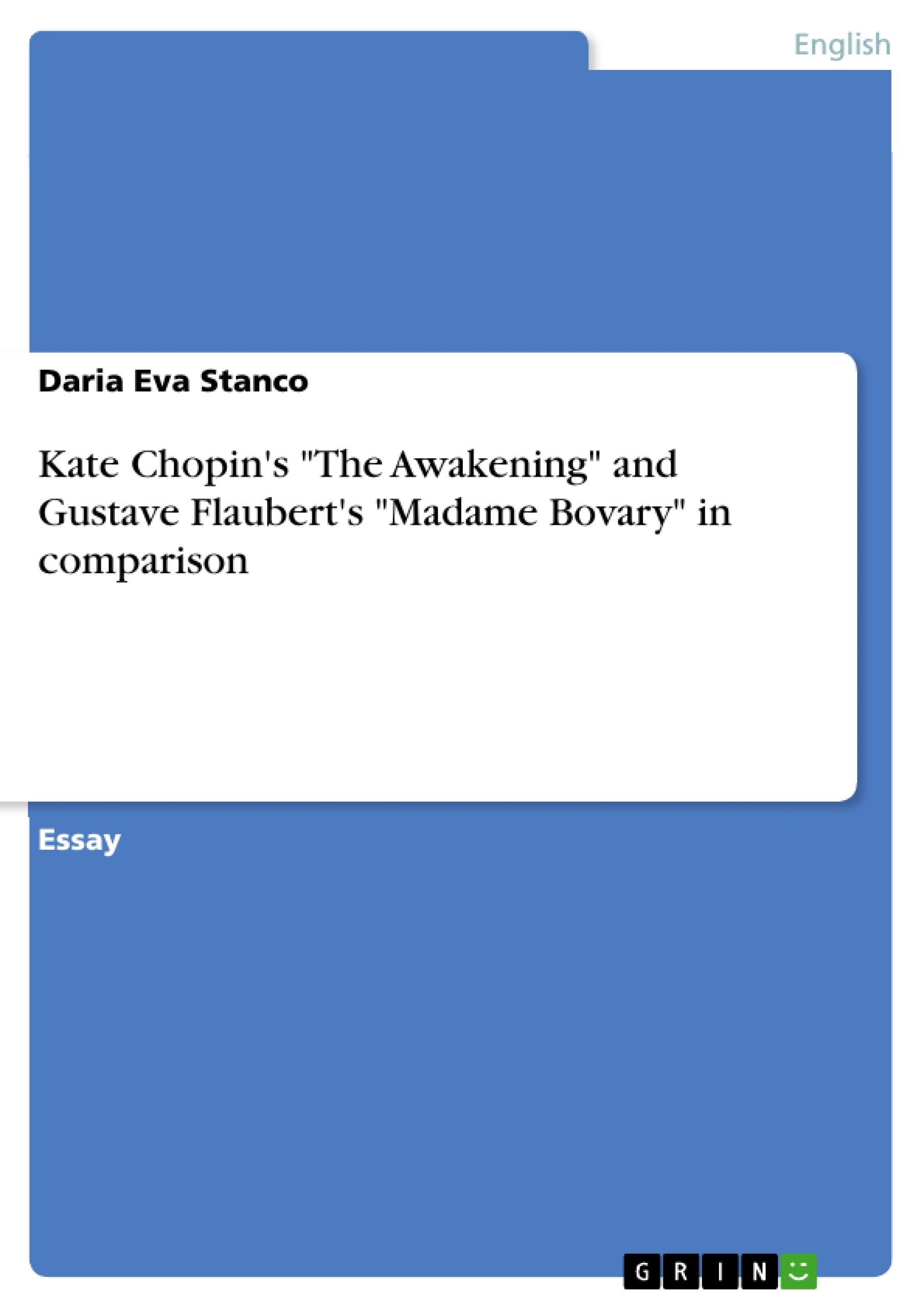Emma Bovary and Edna Pontellier are two of many nineteenth-century female protagonists who fail in their struggles out of the boredom of married life. Among Anna Karenina, Effi Briest, Hedda Gabler and others, they, too, commit suicide. In this essay, Gustave Flaubert’s “Madame Bovary” will be compared to the American novel “The Awakening” by Kate Chopin. First of all, general similarities and differences, such as the historical background, characters, plot, conflicts and motifs, will be examined. In the third chapter, the scenes of suicide will be compared more closely in order to point out the differences between Chopin and Flaubert concerning language and style. Finally, a summarizing conclusion will be given.
Inhaltsverzeichnis (Table of Contents)
- I. Introduction
- II. General Comparison
- a. Historical Background
- b. Characters and Plot
- III. The Suicide Scenes in Comparison
- IV. Conclusion
Zielsetzung und Themenschwerpunkte (Objectives and Key Themes)
This essay aims to compare and contrast Kate Chopin's "The Awakening" and Gustave Flaubert's "Madame Bovary," focusing on the similarities and differences between the two novels. The analysis explores how the historical context, character development, plot structures, and thematic concerns shape the narratives.
- The impact of societal expectations on women in the 19th century.
- The exploration of female desire and its consequences.
- The role of romantic ideals and their disillusionment.
- Contrasting portrayals of female identity and self-discovery.
- The use of literary styles (Realism and Romanticism) in shaping narrative.
Zusammenfassung der Kapitel (Chapter Summaries)
Introduction: This introductory chapter sets the stage for a comparative analysis of "Madame Bovary" and "The Awakening," introducing the two protagonists, Emma Bovary and Edna Pontellier, as nineteenth-century women who struggle against the constraints of their societal roles and ultimately take their own lives. It outlines the essay's structure, promising a general comparison of the novels followed by a closer examination of the suicide scenes and a concluding summary.
General comparison: This chapter delves into a detailed comparison of the two novels across various aspects. The historical background is examined, highlighting the similarities and differences arising from the temporal gap between their publications and the rise of the feminist movement. The chapter analyzes the protagonists' personalities, motivations, and the development of their romantic entanglements. Both Emma and Edna are depicted as victims of societal expectations and the limitations placed upon women of their time. Their marriages are portrayed as sources of boredom and oppression, driving them to seek fulfillment in extramarital affairs. The chapter further explores the literary styles employed by Flaubert and Chopin, noting the realistic elements in both novels while acknowledging the romantic undertones in Chopin's work and Flaubert’s critique of romanticism. The parallel structures of the protagonists' romantic relationships are highlighted, emphasizing the pattern of initial infatuation, abandonment, and subsequent affairs.
Schlüsselwörter (Keywords)
Kate Chopin, Gustave Flaubert, The Awakening, Madame Bovary, 19th-century literature, female protagonists, societal constraints, romantic disillusionment, suicide, realism, romanticism, feminism, female identity, adultery.
Frequently Asked Questions: A Comparative Analysis of "The Awakening" and "Madame Bovary"
What is the main purpose of this essay?
This essay aims to provide a comparative analysis of Kate Chopin's "The Awakening" and Gustave Flaubert's "Madame Bovary," focusing on the similarities and differences between the two novels. The analysis explores how historical context, character development, plot structures, and thematic concerns shape the narratives.
What are the key themes explored in the essay?
The essay explores several key themes, including the impact of societal expectations on 19th-century women, the exploration of female desire and its consequences, the role of romantic ideals and their disillusionment, contrasting portrayals of female identity and self-discovery, and the use of literary styles (Realism and Romanticism) in shaping the narrative.
What aspects of the novels are compared in the essay?
The essay compares various aspects of "The Awakening" and "Madame Bovary," including the historical background of each novel, the protagonists' personalities and motivations, the development of their romantic relationships, and the literary styles employed by the authors. A detailed comparison of the suicide scenes in both novels is also included.
How does the essay structure its comparison?
The essay is structured into four main sections: an introduction, a general comparison of the novels, a detailed comparison of the suicide scenes, and a conclusion. The general comparison delves into the historical context, character analysis, plot structures, and literary styles. The comparison of the suicide scenes provides a deeper analysis of the protagonists' final acts.
What are the key differences between the literary styles of Chopin and Flaubert?
While both novels utilize elements of realism, the essay notes romantic undertones in Chopin's work, contrasting with Flaubert’s more critical approach to romantic ideals. The essay analyzes how these stylistic differences contribute to the overall narrative and portrayal of the female protagonists.
What is the significance of the suicide scenes in the novels?
The essay dedicates a specific section to a close analysis of the suicide scenes in both novels, exploring their significance within the broader context of the narratives. This analysis likely examines the motivations behind the suicides and the implications for the portrayal of female agency and societal limitations.
Who are the main characters discussed in the essay?
The main characters analyzed are Emma Bovary from Flaubert's "Madame Bovary" and Edna Pontellier from Chopin's "The Awakening." The essay examines their personalities, motivations, and the impact of societal constraints on their lives.
What are the key words associated with this comparative analysis?
Key words include: Kate Chopin, Gustave Flaubert, The Awakening, Madame Bovary, 19th-century literature, female protagonists, societal constraints, romantic disillusionment, suicide, realism, romanticism, feminism, female identity, adultery.
What is the overall conclusion of the essay?
The conclusion summarizes the key findings of the comparative analysis, potentially highlighting the significant similarities and differences between the two novels and their implications for understanding female identity and societal expectations in the 19th century.
- Quote paper
- Daria Eva Stanco (Author), 2007, Kate Chopin's "The Awakening" and Gustave Flaubert's "Madame Bovary" in comparison, Munich, GRIN Verlag, https://www.hausarbeiten.de/document/88424


